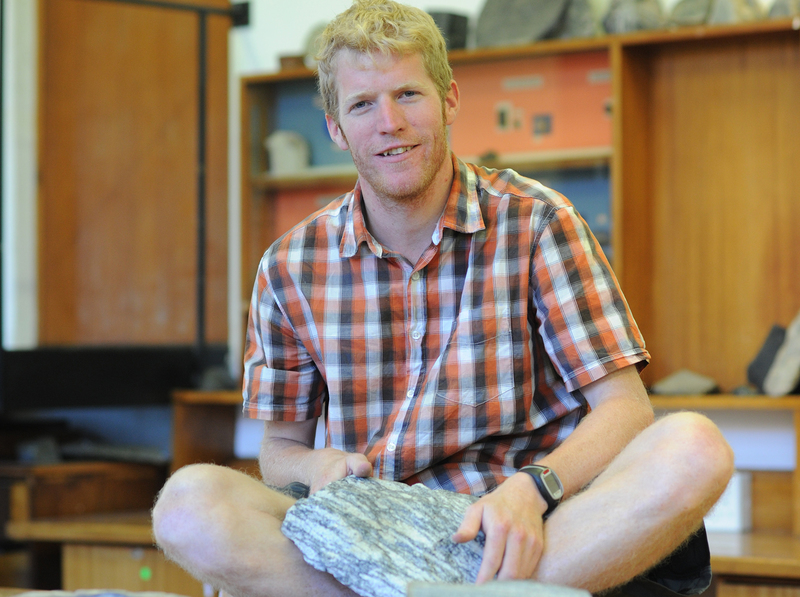Seismic counts for earthquake geologist
02 April 2013
It's not hard to see where Dr Åke Fagereng's heart lies. In his workspace, geological maps hang like wallpaper, the floor home to hunks of rock - some nearly as old as time - and a scree-like jumble of snow skis and boots. At just 30, the earthquake geologist and lecturer in structural geology in the Department of Geological Sciences is five years inside the National Research Foundation's age limit for P-ratings. These can be awarded only once, but there is an expectation that the recognition and support (there's a grant attached to the P-rating) will grow not only his body of work, but a new generation of young geologists in his wake.
Fagereng (his first name is pronounced 'Oke') got his PhD only three years ago, but already has a sizeable publications list, mostly papers published in the past two years. He's recently back from Antarctica where he camped out "in surprisingly good weather", some 150 to 200km inland from the South African base, to collect rock samples in the Sverdrup Mountains. With funding from the South African National Antarctic Programme, the UCT alumnus is conducting a three-year project to study deep crustal processes recorded in the Antarctic rocks. That means looking for ancient, active fault lines that have been exposed to high temperatures and pressures from the Earth's shifting plates.
Studying the microscopic properties and formation of rocks, Fagereng unravels the age-old stories rocks tell about the geophysical processes that occur deep in the Earth's crust. His recent research is broadening understanding of subduction zone fault processes (where one tectonic plate is forced under another after colliding), particularly those factors that affect the 'seismic style' of the subduction megathrust interface. The latter occurs when the ocean floor is forced under a continent and slip occurs on this interface. How the interface responds (its 'seismic style') determines whether it produces large earthquakes like those in Japan and Sumatra, or creeps along slowly and silently, as is the case in the Philippines.
Fagereng also studies the physical processes behind the recently discovered seismic phenomena of episodic tremor. These are 'earthquakes' of very low frequency and slow slip, characterised by seismic rumbling, or tremor, and slow slip along the tectonic plates. Usually, these events are imperceptible to humans and are not destructive. In a couple of weeks he'll wing his way to New Zealand (he completed his PhD at the University of Otago, Dunedin, in 2010) to work with collaborators on the development of theoretical models for fault behaviour and conditions. They'll compare geological observations in well-studied exhumed fault zones; regions of rock showing significant displacement along the fractures as a result of movement in the Earth's crust.
"The aim is to recognise and understand fossil examples of observed active seismic processes." This involves mapping exhumed faults, analysing the microstructures of the deformed rocks found here and conducting laboratory analyses of these to understand the seismic activity and conditions that were present at the time. A large chunk of his work will also be done off-shore, drilling through a fault section between the Pacific and Australian tectonic plates, a major subduction or earthquake zone; down through 2km of water and 6km of rock.
Fagereng is renowned among the 'fault community' for his extraordinary integration of geological and geophysical data. His geological maps trace and document fault lines, those places where the rock formations and chemical compositions point to weaknesses in the Earth's crust. The field studies (those dusty boots in the corner have travelled!) are used to elucidate seismogenic behaviour.
In June he's taking a group of students to Damaraland, Namibia, where he's already worked for some time on the Naukluft Thrust. He also has students working in the Cape Fold Mountains on a project to monitor intraplate seismicity at a microseismic scale. This project is funded by the South African-German collaborative Inkaba ye Africa project.
 This work is licensed under a Creative Commons Attribution-NoDerivatives 4.0 International License.
This work is licensed under a Creative Commons Attribution-NoDerivatives 4.0 International License.
Please view the republishing articles page for more information.









